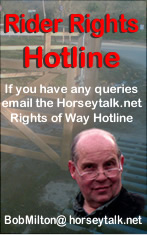
Horseytalk.net/Hoofbeat EXCLUSIVE
RIDER RIGHTS

Hankley Common nr Thursley Surrey
- Why does the public have to pay to correct the Land Registry foul-up.
- The Land Registry are appallingly lax in their checks on first registrations of land.
Says Bob Milton and Sandra Smith

 As we all now know and as set out in Smith v Land Registry it is not possible to claim adverse possession of a publicly maintainable highway and medium filum likewise does not apply where the way is vested in the Surveyor of Highways. Yet this is exactly what has happened on two roads which are on the definitive map as bridleways but are not on the list of streets in an area called Hankley Common nr Thursley Surrey. The adjacent land is part of the Surrey Military Commons, criss-crossed by sandy bridleways and about half of it subject to a Section 193(2) deed of declaration made in the 1920's.
As we all now know and as set out in Smith v Land Registry it is not possible to claim adverse possession of a publicly maintainable highway and medium filum likewise does not apply where the way is vested in the Surveyor of Highways. Yet this is exactly what has happened on two roads which are on the definitive map as bridleways but are not on the list of streets in an area called Hankley Common nr Thursley Surrey. The adjacent land is part of the Surrey Military Commons, criss-crossed by sandy bridleways and about half of it subject to a Section 193(2) deed of declaration made in the 1920's.
Early in 2012, the Commanding Officer of Longmoor Camp let it be known that he planned to close a large and very popular public car park on the common and restrict it to military use only. This followed the closure of other smaller car parks at the edges of the common. This car park is used by walkers and riders who box in. The MoD began to erect a metal barrier across the width of the bridleway leading to the car park there being already one just past the car park access also across the whole width of the highway! A few panicked phone calls to Surrey County Council's Rights of Way department ensured that this new gate construction was halted.
Following representations from local councillors, the CO reluctantly agreed to build a replacement car park elsewhere and off another definitive bridleway some 200m away but this one was about 15% of the original size and patently would not handle demand especially at weekends and bank holidays, nor allow for equestrians. It gradually emerged that it was his deliberate intention to significantly reduce the number of people using the commons for recreation and access, as he planned to make more use of it for military training.
During 2012 the MoD quietly applied for and was granted adverse possession (squatter's rights) on the bridleway which they didn't own, leading to the publicly accessible car park, despite meeting none of the criteria for gaining squatters rights and not even signing their application or having it independently verified. The Statement of Truth submitted by them to the Land Registry failed to mention that the road was a Public Highway maintainable at public expense and actually (mis)stated that the public used the land ie highway, by permission. The Land Registry's own guidance makes it clear it is not possible to gain ownership of such a highway by adverse possession. When this was pointed out to the Land Registry they took a position of 'we're only administrators' and declined to act, despite the significant omissions in the Statement of Truth, unless a (chargeable) declaration is made to them. Having now received written confirmation from the local Highway Authority that the highway is maintainable at public expense, this declaration has been made,
The question that arises from this is -why does the public have to pay to correct the Land Registry foul-up?
During the course of research, it emerged that this bridleway was in fact a Public Carriage Road, stated as such in the Elstead Inclosures of 1857. A Public Driftway or Heath Road (width 30') was set out over this road to provide for the movement of animals between the Inclosures, but the underlying Public Carriage Road was not closed.
This status is confirmed in the Finance Act 1912 maps, showing the Heath Roads as White Roads. Other driftways / heath roads were also uncovered during the research so DMMO (Definitive Map Modification Orders) now have to be submitted to (a) define the width of bridleways as 30' (the normal default is 15') and (b) to upgrade one bridleway to a vehicular carriageway of some sort, although we are nervous about inadvertently opening the commons to 4wd vehicles.
The width definitions are important as the MoD have dug trenches at the side of another bridleway to prevent people from parking there, and this means that it is quite hazardous for riders encountering moving cars on the narrowed road. These trenches are now due to be filled in after intervention by the highway authority / RoW
What this has shown us is that:-
(a) that some in the MoD /Defence Estates have little understanding of highway law, and are quite prepared to erect unlicensed gates and dig unlawful trenches. This is despite a s31(6) declaration for all the land they own and lease being made by a different department at about the same time and which clearly excludes the claimed land from ownership.
(b) the original local rights of way definitive map process did not consider the information in the Inclosure Awards or the Finance Maps.
(c) the Land Registry are appallingly lax in their checks on first registrations of land. We have six examples at the moment of first registration by adverse possession or claims of lost grant of registered commons all of which are managed by Local Authorities under Commons Act 1899 as Schemes of Regulation and are s193 commons. The Local Authority Scheme Managers are it seems never aware of the claim until too late as the Land Registry ignores anything to do with the Commons Register. These registers are mutually exclusive except that the Commons Register shows the Land Registry entry but that does not apply to in reverse with the Land Registry.
(d) It also seems from a number of examples we have that first registration is being granted to Local Authorities where the common land is vested as a result of the Commons Registration Act 1965 [s8/9] for the protection of the land. The land is then treated as freehold title by the Local Authority under s122/3 Local government Act 1972



